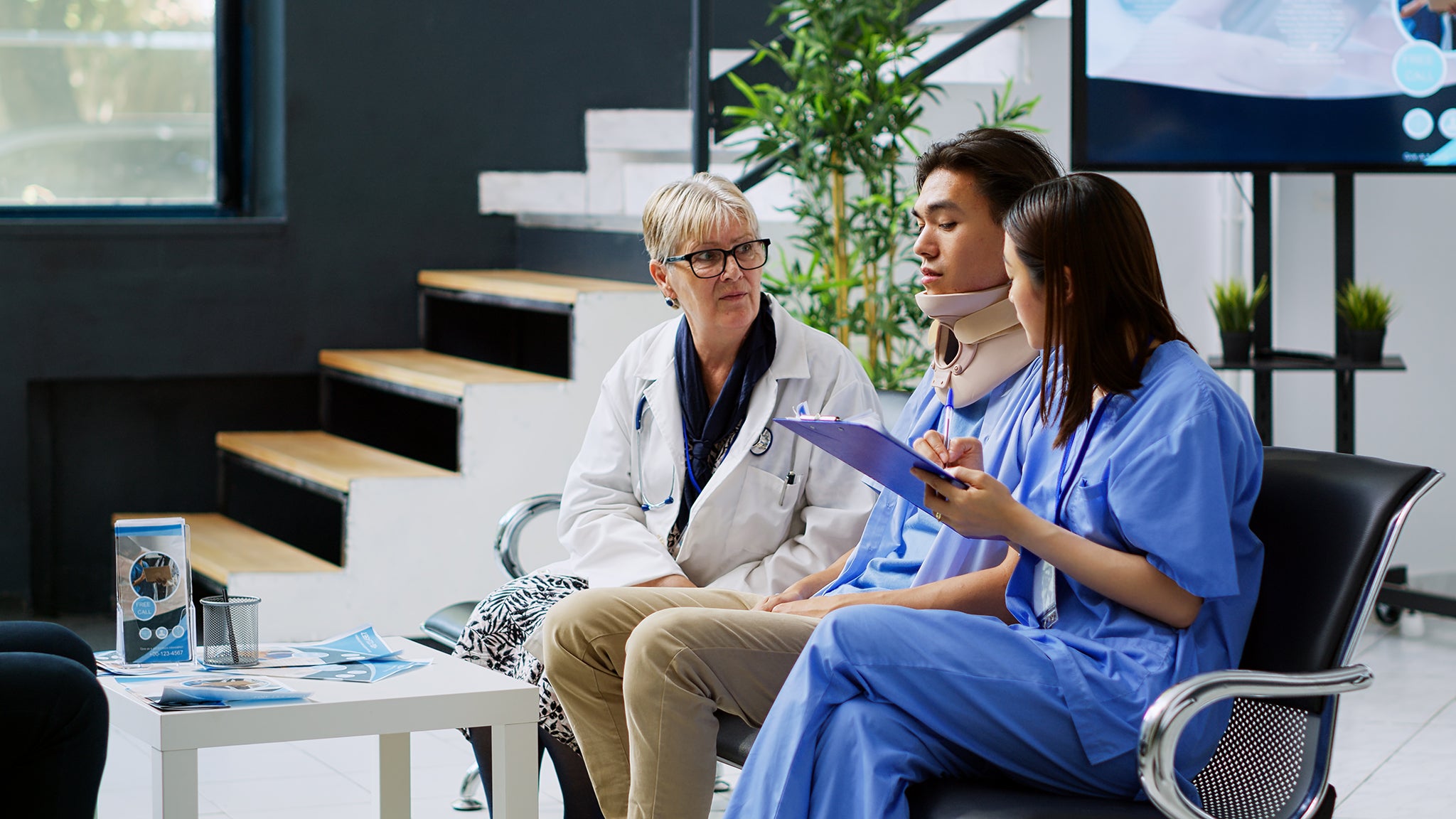You have no items in your shopping basket.
Technology’s role in enhancing clinical observations
Harnessing technology to revolutionise clinical observations in UK health and social care
Dr Richard Dune
06-03-2024
Technology integration within UK health and social care settings has marked a transformative era in clinical observations. This blog explores technology's pivotal role in enhancing the accuracy, efficiency, and overall quality of patient care through advanced clinical observations.
In this blog, Dr Richard Dune explores technology's pivotal role in enhancing the accuracy, efficiency, and overall quality of patient care through advanced clinical observations.
The evolution of technology in healthcare observations
Historically, clinical observations were manually recorded, prone to human error, and time-consuming. Digital technology has revolutionised these processes, introducing a new level of precision and reliability in patient monitoring.
Key facts and statistics
- Adopting electronic health records (EHRs) has reduced clinical errors by up to 50%.
- Digital monitoring systems have improved the detection of patient deterioration, decreasing emergency admissions by approximately 30%.

Image by svitlanah via Envato Elements

Image by DC_Studio via Envato Elements
Key definitions
Clinical observations
Clinical observations are assessments involving the monitoring of vital signs to gauge a patient's health status.
Electronic Health Records (EHRs)
Electronic health records are digital versions of patients' paper charts, providing real-time patient-centred records.
Digital monitors
Digital monitors are devices used to monitor vital signs, offering continuous, instant data analysis.
Relevant legislation, regulations, and best practice
The UK's Care Quality Commission (CQC) mandates the use of technology to ensure high-quality care. Guidelines from the National Institute for Health and Care Excellence (NICE) also recommend integrating digital tools to enhance clinical observations.

Image by ktsimage via Envato Elements

Image by FabrikaPhoto via Envato Elements
Review of current technologies
Digital monitors
Devices like digital blood pressure cuffs and pulse oximeters allow for real-time, accurate measurements of vital signs, significantly reducing the margin for error.
Electronic Health Records (EHRs)
EHRs have revolutionised how patient data is stored, accessed, and utilised, ensuring that healthcare professionals have immediate access to patient histories, allergies, and previous observations.
Wearable technology
Wearable devices enable continuous monitoring of patient's vital signs, alerting healthcare providers to any changes that may indicate deterioration or improvement.
Remote monitoring tools
These tools have been particularly beneficial in home care settings, allowing for monitoring patients' vital signs without the need for constant physical presence, which has been crucial during the COVID-19 pandemic.
The benefits of technology
Accuracy
Digital tools minimise human error in recording and interpreting patient data, leading to more accurate clinical observations.
Efficiency
Technology streamlines the process of clinical observations, freeing healthcare professionals to spend more time on patient care.
Continuous monitoring
Digital monitors and wearable technology provide continuous monitoring of vital signs, enabling the early detection of patient deterioration.

Image by IrynaKhabliuk via Envato Elements

Image by BLACKDAY via Envato Elements
Future trends in technology for clinical observations
Artificial Intelligence (AI)
AI and machine learning are expected to play a significant role in analysing patient data, predicting health outcomes, and suggesting interventions.
Internet of Medical Things (IoMT)
The expansion of connected devices will enhance the ability to monitor patients in real-time, both in clinical settings and remotely.
Virtual Reality (VR) and Augmented Reality (AR)
These technologies are beginning to be used for training healthcare professionals, offering realistic simulations of clinical scenarios.
Recommendations
To fully leverage technology in enhancing clinical observations, UK health and social care settings should:
- Continue to invest in and adopt the latest technological innovations.
- Ensure that all healthcare professionals are adequately trained in the use of digital tools.
- Maintain robust data protection measures to safeguard patient information.
- Engage in ongoing research to evaluate the effectiveness of technological interventions.

Image by RossHelen via Envato Elements

Image by Wavebreakmedia via Envato Elements
Conclusion
Technology has undeniably become a cornerstone of modern clinical observations, offering unparalleled accuracy, efficiency, and patient safety advantages. As we look to the future, the continued evolution and integration of technological solutions in healthcare promise to further revolutionise patient monitoring and care. By embracing these innovations, UK health and social care settings can continue improving outcomes and setting new patient care standards.
Stay at the forefront of healthcare innovation with our accredited online training courses on the latest clinical observation technologies. Enhance your skills, improve patient care, and lead the way in adopting cutting-edge solutions. Discover our courses today and take the first step towards a future of enhanced patient safety and care quality.
Technology integration within UK health and social care settings has marked a transformative era in clinical observations. This blog explores technology's pivotal role in enhancing the accuracy, efficiency, and overall quality of patient care through advanced clinical observations.
In this blog, Dr Richard Dune explores technology's pivotal role in enhancing the accuracy, efficiency, and overall quality of patient care through advanced clinical observations.
The evolution of technology in healthcare observations

Image by svitlanah via Envato Elements
Historically, clinical observations were manually recorded, prone to human error, and time-consuming. Digital technology has revolutionised these processes, introducing a new level of precision and reliability in patient monitoring.
Key facts and statistics
- Adopting electronic health records (EHRs) has reduced clinical errors by up to 50%.
- Digital monitoring systems have improved the detection of patient deterioration, decreasing emergency admissions by approximately 30%.
Key definitions

Image by DC_Studio via Envato Elements
Clinical observations
Clinical observations are assessments involving the monitoring of vital signs to gauge a patient's health status.
Electronic Health Records (EHRs)
Electronic health records are digital versions of patients' paper charts, providing real-time patient-centred records.
Digital monitors
Digital monitors are devices used to monitor vital signs, offering continuous, instant data analysis.
Relevant legislation, regulations, and best practice

Image by ktsimage via Envato Elements
The UK's Care Quality Commission (CQC) mandates the use of technology to ensure high-quality care. Guidelines from the National Institute for Health and Care Excellence (NICE) also recommend integrating digital tools to enhance clinical observations.
Review of current technologies

Image by FabrikaPhoto via Envato Elements
Digital monitors
Devices like digital blood pressure cuffs and pulse oximeters allow for real-time, accurate measurements of vital signs, significantly reducing the margin for error.
Electronic Health Records (EHRs)
EHRs have revolutionised how patient data is stored, accessed, and utilised, ensuring that healthcare professionals have immediate access to patient histories, allergies, and previous observations.
Wearable technology
Wearable devices enable continuous monitoring of patient's vital signs, alerting healthcare providers to any changes that may indicate deterioration or improvement.
Remote monitoring tools
These tools have been particularly beneficial in home care settings, allowing for monitoring patients' vital signs without the need for constant physical presence, which has been crucial during the COVID-19 pandemic.
The benefits of technology

Image by IrynaKhabliuk via Envato Elements
Accuracy
Digital tools minimise human error in recording and interpreting patient data, leading to more accurate clinical observations.
Efficiency
Technology streamlines the process of clinical observations, freeing healthcare professionals to spend more time on patient care.
Continuous monitoring
Digital monitors and wearable technology provide continuous monitoring of vital signs, enabling the early detection of patient deterioration.
Future trends in technology for clinical observations

Image by BLACKDAY via Envato Elements
Artificial Intelligence (AI)
AI and machine learning are expected to play a significant role in analysing patient data, predicting health outcomes, and suggesting interventions.
Internet of Medical Things (IoMT)
The expansion of connected devices will enhance the ability to monitor patients in real-time, both in clinical settings and remotely.
Virtual Reality (VR) and Augmented Reality (AR)
These technologies are beginning to be used for training healthcare professionals, offering realistic simulations of clinical scenarios.
Recommendations

Image by RossHelen via Envato Elements
To fully leverage technology in enhancing clinical observations, UK health and social care settings should:
- Continue to invest in and adopt the latest technological innovations.
- Ensure that all healthcare professionals are adequately trained in the use of digital tools.
- Maintain robust data protection measures to safeguard patient information.
- Engage in ongoing research to evaluate the effectiveness of technological interventions.
Conclusion

Image by Wavebreakmedia via Envato Elements
Technology has undeniably become a cornerstone of modern clinical observations, offering unparalleled accuracy, efficiency, and patient safety advantages. As we look to the future, the continued evolution and integration of technological solutions in healthcare promise to further revolutionise patient monitoring and care. By embracing these innovations, UK health and social care settings can continue improving outcomes and setting new patient care standards.
Stay at the forefront of healthcare innovation with our accredited online training courses on the latest clinical observation technologies. Enhance your skills, improve patient care, and lead the way in adopting cutting-edge solutions. Discover our courses today and take the first step towards a future of enhanced patient safety and care quality.
Related blog articles
View all
Clinical effectiveness and clinical governance: An introduction
Related blog articles
View all
Clinical effectiveness and clinical governance: An introduction
References and resources
National Library of Medicine (2024) - The Impact of an Electronic Patient Bedside Observation and Handover System on Clinical Practice: Mixed-Methods Evaluation - PMC.
National Library of Medicine (2018) - What maximises the effectiveness and implementation of technology-based interventions to support healthcare professional practice? A systematic literature review - PMC.
NHS England (2023) - NHS England » Supporting clinical decisions with health information technology.
Nursing Times (2024) - Improving observation with new technology | Nursing Times.


About The Mandatory Training Group
The Mandatory Training Group is one of the leading UK providers of CPDUK-accredited statutory and mandatory training, continuing professional development (CPD) courses, eLearning software and workforce development solutions for all sectors.
By making things simple and designing interactive e-learning content, we can provide meaningful training programs at all levels and enhance the capacity and resilience of individuals and organisations.
Click here to see our wide range of accredited clinical skills courses and training programmes.
References and resources

National Library of Medicine (2024) - The Impact of an Electronic Patient Bedside Observation and Handover System on Clinical Practice: Mixed-Methods Evaluation - PMC.
Nursing Times (2024) - Improving observation with new technology | Nursing Times.
NHS England (2023) - NHS England » Supporting clinical decisions with health information technology.
National Library of Medicine (2018) - What maximises the effectiveness and implementation of technology-based interventions to support healthcare professional practice? A systematic literature review - PMC.
About The Mandatory Training Group

The Mandatory Training Group is one of the leading UK providers of CPDUK-accredited statutory and mandatory training, continuing professional development (CPD) courses, eLearning software and workforce development solutions for all sectors.
By making things simple and designing interactive e-learning content, we can provide meaningful training programs at all levels and enhance the capacity and resilience of individuals and organisations.
Click here to see our wide range of accredited clinical skills courses and training programmes.
Contact us
Complete the form below to start your ComplyPlus trial and transform your regulatory compliance solutions.






